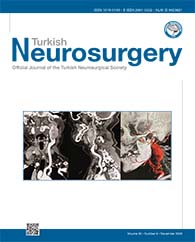2Erciyes Hospital, Department of Neurosurgery, Kayseri, Turkey DOI : 10.5137/1019-5149.JTN.28093-19.2 AIM: To assess the effectiveness and reliability of hemilaminectomy and bilateral decompression (HLBD) for the treatment of thoracic spinal stenosis (TSS) in selected patients.
MATERIAL and METHODS: Clinical data of 21 consecutive adult patients who underwent HLBD were investigated. Patients diagnosed with TSS by computed tomography or magnetic resonance imaging, with stenosis secondary to posterior element hypertrophy, and who underwent HLBD for the treatment of narrow spinal canal were included in this study. Patients were evaluated based on their pre- and postoperative modified Japanese Orthopedic Association (JOA) scores using their medical records. Recovery rates were evaluated using the Hirabayashi?s method.
RESULTS: The mean follow-up period, age, and preoperative JOA score were 37.6 months, 61.6 years, and 5.0 (range: 1?10), respectively. The mean JOA score improved postoperatively, i.e., 10.0 (range: 7?11), during follow-up. The recovery rate was 83.3%. Operation-related transfusion, neurological deterioration, and postoperative instability did not occur during the follow-up examination.
CONCLUSION: HLBD is a suitable surgical technique for patients with stenosis primarily caused by posterior element hypertrophy, such as ligamentum flavum (LF) and facet joints because it has a relatively less complication ratio, protects the posterior anatomical structures, prevents post-laminectomy kyphosis and postoperative instability, and promotes successful clinical improvement.
Keywords : Bilateral decompression, Hemilaminectomy, Thoracic spinal stenosis




